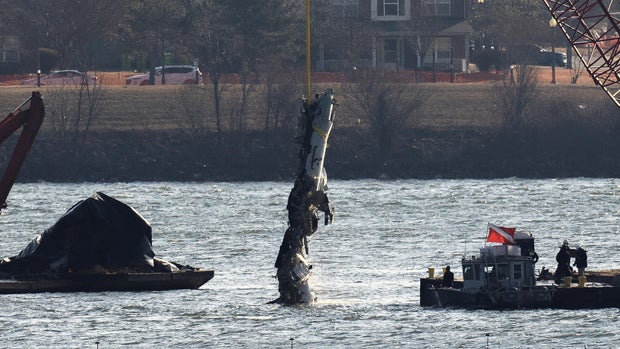Remains from all D.C. plane crash victims recovered as crews pull parts of cockpit, tail from Potomac River
Crews started removing Monday the wreckage of the American Airlines plane that collided with an Army Black Hawk helicopter over Washington, D.C., and crashed into the Potomac River last week.Tuesday, February 4th 2025, 3:37 pm
Remains from all 67 victims of the midair collision over Washington, D.C., that sent an American Airlines regional plane and an Army Black Hawk helicopter crashing into the Potomac River have been recovered, officials said Tuesday.
Officials said in a statement that 66 of the remains have been positively identified.
The development comes as parts of the airliner's cockpit and tail were removed from the water while crews continue the lengthy process of recovering the wreckage.
The pieces were lifted by a crane and placed onto a barge with other parts recovered from the flight that took off from Wichita, Kansas, Wednesday for Washington's Reagan National Airport with 60 passengers and four crew members on board. One of the pieces recovered earlier in the day showed a portion of the American Eagle logo.

Parts of a plane are lifted from the Potomac River near the wreckage site of the midair collision between an American Airlines jet and a Black Hawk helicopter, at Ronald Reagan Washington National Airport, Feb. 4, 2025, in Arlington, Virginia.
Crews began work Monday to salvage the wreckage, recovering the battered midsection of the plane's fuselage, one of the engines and a wing.
"Over the next 24 hours, our goal is really to complete our commitment to finishing the civilian plane recovery," Col. Frank Pera of the U.S. Army Corps of Engineers told reporters Monday.
Officials said it will take several days to remove all of the wreckage.
Newly released drone video from the National Transportation Safety Board shows a first look at the scene hours after the crash, the Black Hawk helicopter appearing mostly intact.
Investigators said they're still poring over the flight data and cockpit voice recorders from both aircraft. They've also obtained training and flight logs for both flight crews, maintenance logs for both aircraft and are building the crews' daily histories.

A crane retrieves part of the wreckage from the Potomac River, in the aftermath of the collision of American Eagle Flight 5342 and a Black Hawk helicopter, by Ronald Reagan Washington National Airport, in Arlington, Virginia, Feb. 4, 2025.
Interviews with all five air traffic controllers working the night of the collision have also been completed as the NTSB tries to piece together what happened.
Amid questions over whether military helicopters should be sharing the same airspace with commercial air traffic, Billy Nolen, a former acting administrator of the Federal Aviation Administration, said they should.
"It happens all the time," Nolen said. "So this is not one of a zero-sum game. We are in this national capital region. What we should look at is, say, have we missed anything in terms of how this is designed, how the routes are designed, and is there anything that we would, should or could do differently to prevent this from happening again?"
As investigators push for answers, a moment of silence was held Monday at skating rinks across the country remembering the 67 lives lost, including those in the ice skating community.
-----
Story from Feb. 3:
Crews started removing Monday the wreckage of the American Airlines plane that collided with an Army Black Hawk helicopter over Washington, D.C., and crashed into the Potomac River last week.
One of the plane's two engines was seen being lifted from the river Monday morning, and a large section of the fuselage was taken out of the water around midday.
Crews spent the weekend positioning key equipment to begin removing the wreckage.
"Our goal is to really lift as much as we can, given the fact that we are also accounting for the human remains component," Col. Francis Pera with the U.S. Army Corps of Engineers told reporters.
Under a massive police escort Sunday, the families of the 67 people killed in Wednesday's collision gathered within sight of the wreckage just off one of the runways at Washington's Reagan National Airport. Officials said 55 bodies have been recovered.
Investigators with the National Transportation Safety Board said black box data indicates the airliner was flying at around 325 feet ahead of the collision. That's well higher than the 200 feet set by the Federal Aviation Administration for helicopter traffic in that area.
According to the NTSB, the airline pilots appeared to pull up about a second before the crash, and investigators are working to understand if the air traffic controllers' screens were providing the helicopter's actual altitude leading up to the collision.
The agency said five people were in the airport control tower Wednesday night. That includes two controllers who CBS News has learned were doing multiple jobs.
"From tragedy, we draw knowledge to improve the safety for us all," NTSB member Todd Inman told reporters. "That's what we're doing right now, dealing with tragedy, but we need to improve safety."
The Army has identified all three people who were on the helicopter as pilots Chief Warrant Officer 2 Andrew Eaves and Capt. Rebecca Lobach and Staff Sgt. Ryan O'Hara, the crew chief.
"These were two experienced, qualified pilots to fly in this local area," said Col. Mark Ott, deputy director of aviation for the Army. "This is something they've done many times before, and they were simply out flying a training mission that's required to re-evaluate, just like every Army pilot does on an annual basis. You get re-evaluated, re-signed off to fly in your local area."
Kathryn Krupnik contributed to this report.
More Like This
February 4th, 2025
February 4th, 2025
February 3rd, 2025
Top Headlines
February 4th, 2025
February 4th, 2025
February 4th, 2025
February 4th, 2025











